In a recent speech at a special operations conference in Washington, D.C., USAF’s top uniformed leader, Gen. Norton A. Schwartz, pledged to better configure the Air Force in order to support American ground forces in combat “whatever is needed, whatever it takes.”
Indeed, that transformation—prompted by years of war in Afghanistan and Iraq—has been under way for some time, and has only picked up speed in recent months.
“My commitment to you is that Air Force leaders are listening and will continue to listen,” the Air Force’s Chief of Staff told his audience on Feb. 11. “We will shape our training and developmental efforts in the officer and NCO ranks to meet the challenges that we face.”
The changes are rippling through the service. Virtually no corner has remained untouched.
However, the transformation is glaringly apparent in three training areas—the actions of airmen on the ground, the use of combat airpower in support of ground forces, and the operation of unmanned air vehicles to enhance battlefield awareness.
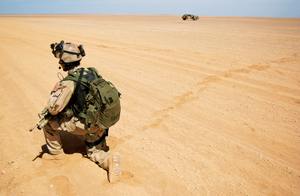 |
A combat controller keeps an eye out for danger during a training mission as the rest of his team sets up an austere runway |
Ground-Force Taskings
When USAF Col. Scott Bethel left for Iraq in July of 2004, his predeployment training consisted of a half-day reacquainting himself with a 9 mm handgun at a local firing range. Bethel had been in Iraq only a few weeks when his truck convoy was ambushed by Iraqi insurgents.
“Basically I got all of my real training in that 90-second firefight, copying how the marines around me returned fire,” said Bethel, who is now deputy director of technical training at Air Education and Training Command at Randolph AFB, Tex.
The day after the ambush, Bethel requisitioned an M-16 assault rifle and took it to the firing range. “That way, I was a little better prepared when my convoy was ambushed a second time two weeks later,” he recounted.
Like many airmen, Bethel knew he had deployed to Iraq with insufficient close-combat skills. The realization that thousands of airmen deploying to war zones must be combat-ready on Day 1 has driven the Air Force to fundamentally reshape its curriculum and training regime.
USAF has modified its two-week, behind-enemy-lines training program called SERE—Survival, Evasion, Resistance, and Escape. Now, airmen deploying to high-risk assignments on the ground undergo a streamlined, four-day course called Evasion and Conduct After Capture, or ECAC.
“A major catalyst for ECAC was the capture of some British sailors by the Iranians,” said Bethel. “Air Force leaders decided [on ECAC for] deploying airmen so that, God forbid, in a similar situation, they would have training to draw on.”
AETC is also developing an intense, two-week predeployment course that further stresses expeditionary skills for airmen about to leave for a war zone.
“Until about 18 months ago, the combat training airmen received was not consistent, and that was frustrating not only for the deployed airmen but also for the Army or Marine Corps units they sometimes augmented,” said Bethel. USAF’s leadership therefore decided “to create a force that is more standardized in its combat and expeditionary training, so that, when an airman arrives in theater, no one has to worry whether he has the required skills.”
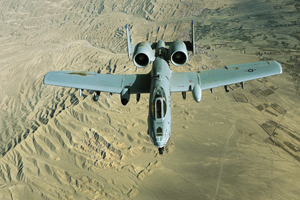 |
An A-10 pilot powers his fighter over the mountains of Afghanistan. |
The wartime standardization begins almost from the first day. USAF recently expanded its Basic Military Training course by two weeks. Basic training was expanded to incorporate the Basic Expeditionary Airman Skills Training (BEAST) exercise, designed to simulate deployment to a forward operating base in the Middle East.
At Lackland AFB, Tex., where BMT is taught, a new BEAST site reflects the gritty reality of an Air Force at war. The facility includes a 1.5-mile improvised explosive device (IED) trail, for instance, where airmen practice spotting roadside bombs.
The BEAST facility also boasts a mock airstrip that airmen learn to secure in the face of simulated air and ground attacks, a nod to the fact that in counterinsurgency warfare, there are no clear battle lines, nor safe rear areas. Everyone is a potential target.
“The Air Force’s focus on the Global War on Terror required a philosophical leap,” said Bethel.
With airmen now “routinely deploying to dangerous war zones and forward areas, the Air Force leadership decided we needed to increase the warrior ethos of the entire force,” he continued. “That required changing our training to emphasize combat and expeditionary skills, and BEAST is a good example of that.”
Airmen deploy to the BEAST facility for a five-day session. There they are issued personal weapons, and required to set up camp in an austere setting. As part of their combat skills training, they will have to repel an opposing force, conduct combat first aid, and cope with a simulated chemical attack using tear gas.
Though an obvious reflection of a more expeditionary Air Force, BEAST is just one example of the new warrior ethos that is coming to define Air Force training.
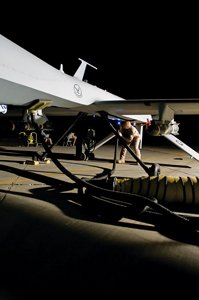 |
Lt. Col. Geoffrey Barnes preflights an MQ-1 Predator at Ali Base, Iraq. USAF is training a quickly expanding force of UAV operators. |
For example, airmen coming out of Officer Training School, the Reserve Officer Training Corps, or the Air Force Academy will have already received Air Combatives Training, a 10-hour block of instruction in hand-to-hand combat techniques. It is adapted from a similar Army program and designed to build confidence and foster teamwork.
Close Support Operations
Nowhere has the impact of Iraq and Afghanistan been more evident than in the renewed Air Force emphasis on close air support.
As a direct result of heavy emphasis on close air support missions in counterinsurgency operations, Air Combat Command has added a third week of CAS training to its Red Flag exercises. In addition, ACC has now resurrected Green Flag. This exercise, however, no longer focuses on electronic warfare skills, as in the past. Rather, it has become USAF’s premier CAS training event.
The new Green Flag partners Air Force squadrons directly with Army brigade combat teams preparing to deploy to Iraq or Afghanistan.
“After 9/11, the nature of the wars in Afghanistan and Iraq developed into counterinsurgencies,” said Maj. Paul Kirmis, director of operations for the 549th Combat Training Squadron, which coordinates Green Flag exercises at Nellis AFB, Nev. “The leadership at Air Combat Command decided we needed to start training to the current fight.”
Counterinsurgency operations put a heavy emphasis not just on CAS, but on armed reconnaissance, efforts to counter dangerous IEDs, intelligence-surveillance-reconnaissance sorties, and convoy escort duties. Nearly all these missions require close operational coordination with Army forces on the ground.
On the vast ranges outside of Nellis Air Force Base, small towns and roads have recently sprouted from the desolate scrub desert. On closer inspection, the villages consist of standard shipping containers arranged in grids to resemble buildings and town squares.
During a recent Red Flag exercise, a joint terminal attack controller hidden in the hills of the range sent the coordinates of one of those “buildings” to a combined air operations center back at Nellis. The CAOC then relayed the information to two F-15E Strike Eagles orbiting overhead.
Within minutes, they were swooping down for a simulated bombing run. In a real world mission, all the participants would know that any snag or misfire in that communications loop could result in a catastrophe.
The new “towns” in the Nellis range, and the heavy emphasis on the close air support mission, are adaptations to urgent combat needs.
While the first two weeks of Red Flag exercises still focus on establishing air superiority, attacking air defenses, and targeting key communications and infrastructure nodes from the air, an additional third week now emphasizes the kinds of close air support missions that pilots and air controllers conduct almost everyday in Afghanistan and Iraq.
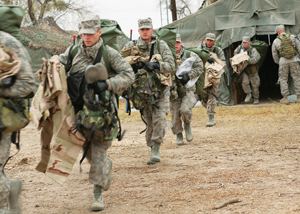 |
USAF basic trainees move out on the BEAST course at Lackland AFB, Tex. (USAF photo by Robbin Cresswell) |
“Adding a third week allowed us to cater completely to the mission of providing close air support in an urban environment, which requires precise communication so that the right targets are hit and friendlies are not killed,” said Lt. Col. Paul Johnson, operations director for the 414th (Red Flag) Combat Training Squadron.
The fluid nature of counterinsurgency operations, he said, also puts a premium on flexibility and rapid response times, with aircraft often being tasked and directed to moving targets while already armed and in the air.
“As a result of operations downrange in Iraq and Afghanistan, we spend a lot of time at Red Flag now practicing ‘dynamic targeting,’ where aircraft receive bombing coordinates while already on station,” said Johnson. “Compressing that ‘kill chain’ so that we can successfully strike time-sensitive targets is something we work on all the time now.”
On some days, joint strike packages take off from Nellis and veer south toward southern California and the Mojave Desert outside of Barstow. This is the home of the Army’s National Training Center (NTC). As part of Green Flag exercises started in 2006, those strike aircraft will take part in training that experts say has unprecedented focus on close air support of ground forces.
The participating Army brigade combat teams are poised to deploy to Iraq or Afghanistan.
“We have really made great strides in terms of helping US Army commanders exercise their ability to request and coordinate close air support, and to integrate all those moving parts,” said Kirmis. “And when we all get it right, it’s really fantastic to see.”
For instance, the Air Force now runs 20 Green Flag exercises each year. Ten are run out of Nellis in support of Army training at the NTC, and 10 out of Barksdale AFB, La., in support of Army training at the Joint Readiness Training Center (JRTC) at Ft. Polk, La.
The most recent Green Flag West exercise was the largest yet, and in 2008, the 549th Combat Training Squadron at Nellis coordinated 226 aircraft, 2,571 sorties, and more than 5,800 flying hours for Green Flag.
As part of the exercises, USAF also locates training squadrons directly with Army counterparts at the NTC and the JRTC to coordinate operations and seamlessly embed joint terminal attack controllers with Army ground forces.
Given the multilateral nature of ongoing conflicts, and the heavy participation of NATO forces in Afghanistan in particular, air forces from Britain, France, Belgium, Germany, the Netherlands, and Italy have either participated in Green Flag exercises or plan to do so soon.
Meanwhile, Air Force tactics experts from Nellis and Barksdale travel to Iraq and Afghanistan multiple times each year, returning to brief Green Flag participants on the most up-to-date challenges and rules of engagement in those combat theaters.
“Providing close air support is very complex, and we need to work the communication and coordination aspects really hard in order to provide the ground commander the right set of options,” said Kirmis.
In some situations where the risk of collateral damage is high, he said, the right option might be for the pilot to recommend against bombing. “He might tell the ground commander that it’s better to use his other resources to solve the problem, whether that’s artillery, helicopters, or even boots on the ground,” said Kirmis.
He said the overall goal of Green Flag is the same as at Red Flag: Give the young pilot or ground-based air controller experience equivalent to the first 10 combat sorties—statistically the most dangerous in terms of both casualties and mistakes.
“With Green Flag, we want to take the young wingmen [who have] never been to war, and put them under combat-like stresses, so they are prepared the very first day they hit that ramp at Bagram,” Kirmis said. “When they get that first call from US troops under fire, at night in bad weather, in a complex urban environment where there are friendlies and neutral civilians in close proximity to bad guys, that young wingman has to be ready.”
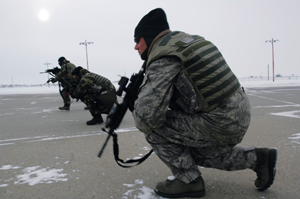 |
Security forces airmen train on the frigid flight line at Minot AFB, N.D. (USAF photo by A1C Jesse Lopez) |
Unmanned Aircraft World
Offering major challenges, too, is the service’s push to make more extensive use of modern unmanned aerial vehicles in irregular warfare. Particularly evident is the rising number of pilots needed for USAF’s burgeoning UAV fleet.
Skyrocketing requests for unmanned aerial vehicle support in Iraq and Afghanistan have dictated that roughly 100 pilot trainees be made available each year directly to train to fly UAVs such as the MQ-1 Predator and MQ-9 Reaper.
Under a new test program, Air Force captains in nonflying military specialties are also being trained as UAV pilots. The first class will graduate from the eight-month course later this year, and if they are successful, AETC intends to expand the program.
The UAV community continues to see refinement. In recent years, when officials “began briefing graduating classes of pilots and explained the need and the capabilities of the unmanned systems, believe it or not, a lot of folks raised their hand and signed up to UAVs on the spot,” said then-Col. Carlton D. Everhart II, at the time AETC’s deputy director of flying training.
As a result, he said, roughly 100 graduates of pilot training each year are now switching to UAVs. “We were pleasantly surprised.”
“As a result of the wars in Iraq and Afghanistan, we’ve definitely had to change how we think about UAV pilots and systems operators as career paths,” said Everhart.